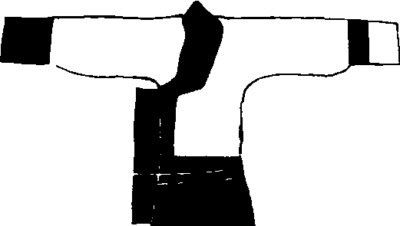Chapter 9 Section 2 men's clothing
During the Qin and Han Dynasties, men's common clothes were robes.This is a kind of clothing that originated from Shenyi in the pre-Qin period.Originally, it was only used as the inner lining of the dress worn by scholar-bureaucrats or home clothes.When scholar-bureaucrats go out or meet guests at banquets, they must wear clothes and skirts.It was not until the Eastern Han Dynasty that the robe began to be used as a dress worn by officials at court meetings and courtesy meetings.Most of them have large sleeves, and the cuffs have obvious convergence.The wide part of the sleeves is called Meimei, and the tight part of the cuffs is called Qu.Lace trims the collar and cuffs.The collar is mainly exposed.It is usually cut into a chicken heart style, revealing the inner clothes when worn.In addition, there is also a large slanted collar, the skirt is opened lower, the leader is decorated with lace, and a row of dense pleats is often placed under the robe, and sometimes it is cut into a crescent moon shape.In addition, gowns are not only clipped, but also winter clothes filled with cotton wool.Specifically, it can be divided into 纩〔kuang mine〕 gown (made of thin new silk and cotton), and 缊〔yunyun〕 gown (made of old or new silk and thick and short), etc.When censors or other civil officials wear robes and go to court, there is often a white pen inserted into the hairpin on the right ear as decoration (transformed from preparing notes) called "hairpin white pen".Officials usually wear Zen (dan single, that is, single clothes) clothes.A Zen robe is a thin, single-layer gown without a lining, made of cloth or thin silk.The robes of this period can be roughly divided into two types: one is straight and the other is curved.Qufu is the deep garment of the Warring States period, which was mostly seen in the early years of the Han Dynasty.This style is not only worn by men, but also the most common style in women's clothing.This kind of clothing is tight and narrow, with a long bottom that drags the floor. The hem of the clothes is mostly trumpet-shaped, and the feet are not exposed.The sleeves are wide and narrow, and the cuffs are often trimmed.Collars are usually cross-collared, with a low neckline to reveal the garment underneath.Sometimes there are more than three layers of collars exposed, so it is also called "triple clothes".Straight train, also known as 襜褕, was worn by ordinary men in the Eastern Han Dynasty.Its placket intersects to the back of the left chest and falls vertically to the hem.It is a variant of (alternate single) clothing, not a formal dress, and should not be worn on grand occasions.According to the "Book of Han: Enze Hou Biao No. 6", Wu'an Hou Tiantian of the Han Dynasty was exempted from the country because he was "disrespectful" by Emperor Wu because he followed the fashion and "entered the palace in poor clothes".

襜褕
During the Qin and Han Dynasties, men's short garments mainly consisted of underwear and outer garments.The representative clothing of underwear is shirt and (衤尃) [bobo].Shirt, also known as Shan Ru, is a single underwear without sleeves (the one without sleeves is called a sweater, and its shape is like today's vest). (衤尃) is a clip-on underwear with the same shape as a shirt, also known as a "short clip-on shirt".In addition, there are Pafu (a piece of cloth wrapped horizontally on the abdomen), Baofu (with a belt on the Papua, which hugs the abdomen tightly, which is commonly known as Doudu in later generations), Xinyi (adding "hook shoulders" and "Crotch") and other underwear with only the front piece, as well as two pieces at the front and back, which can be used as both the chest and the back. Underwear called "liangdang (meaning to block)".Commoner men also wear crotch-filled triangular shorts called “Cubishi”.It is said to be named for its shape like a calf's nose. "Historical Records" records the historical fact that Sima Xiangru, a Fu writer in the Han Dynasty, eloped with Zhuo Wenjun and opened a wine shop on the streets of Chengdu. Biography of Sima Xiangru").
The representative clothing of outerwear is Ru and Xi.Ru is a short jacket with cotton wool.Because it is only knee-length, it must be worn with crotch pants.At that time, the nobles often used Wan (thin and white plain thin silk) as trousers, so it was called "Wan trousers".Later, the word gradually evolved into a synonym for swingers.Xie, also known as pleats, is a short jacket without cotton wool.
The Han Dynasty also implemented the wearing ribbon system.High-ranking officials and officials wear hanging ribbons.The group is an ornament made of ribbons that can be used to tie the waist.Ribbon is a belt used to tie jade pendants or seal buttons.There are red, green, purple, blue, black, yellow and other colors.It is a symbol of official power in the Han Dynasty and was issued by the imperial court.According to regulations, when an official goes out, he must put his official seal in a bag made of leather or colorful brocade at his waist, and expose the seal ribbon outside and hang down.That is the so-called "carrying the golden seal, and tying the purple ribbon on the waist (waist)" ("Historical Records Biography of Fan Sui Cai Ze").People can then judge their status according to the size, color and fineness of the weaver's ribbon worn by officials.

襜褕
